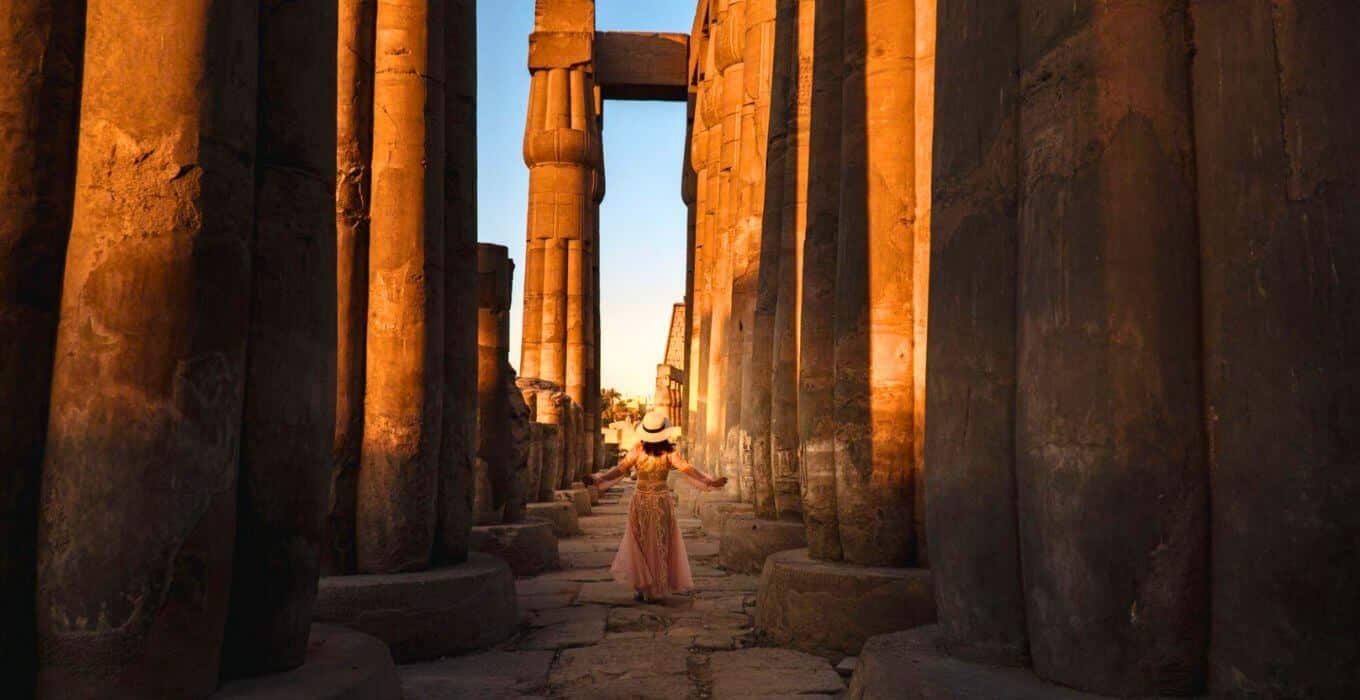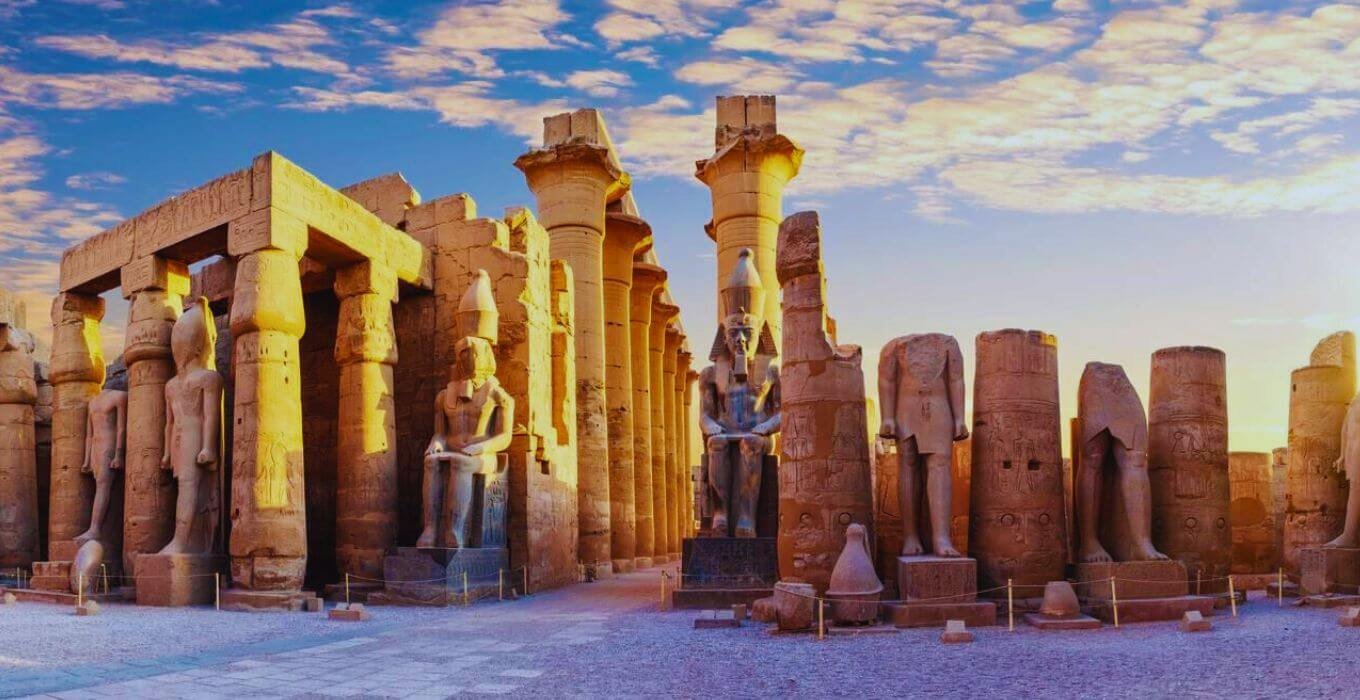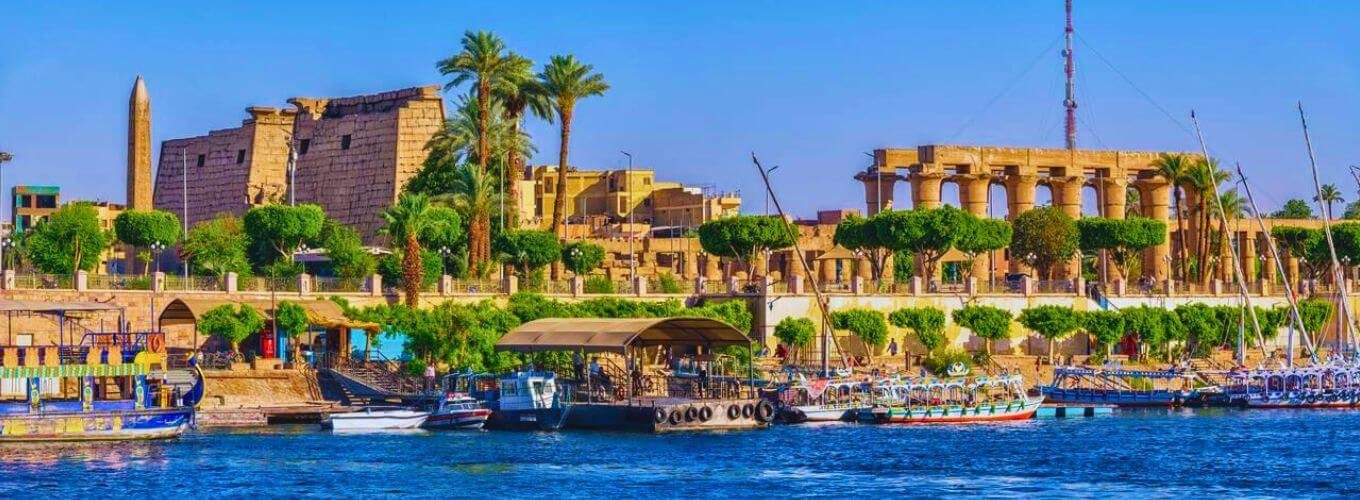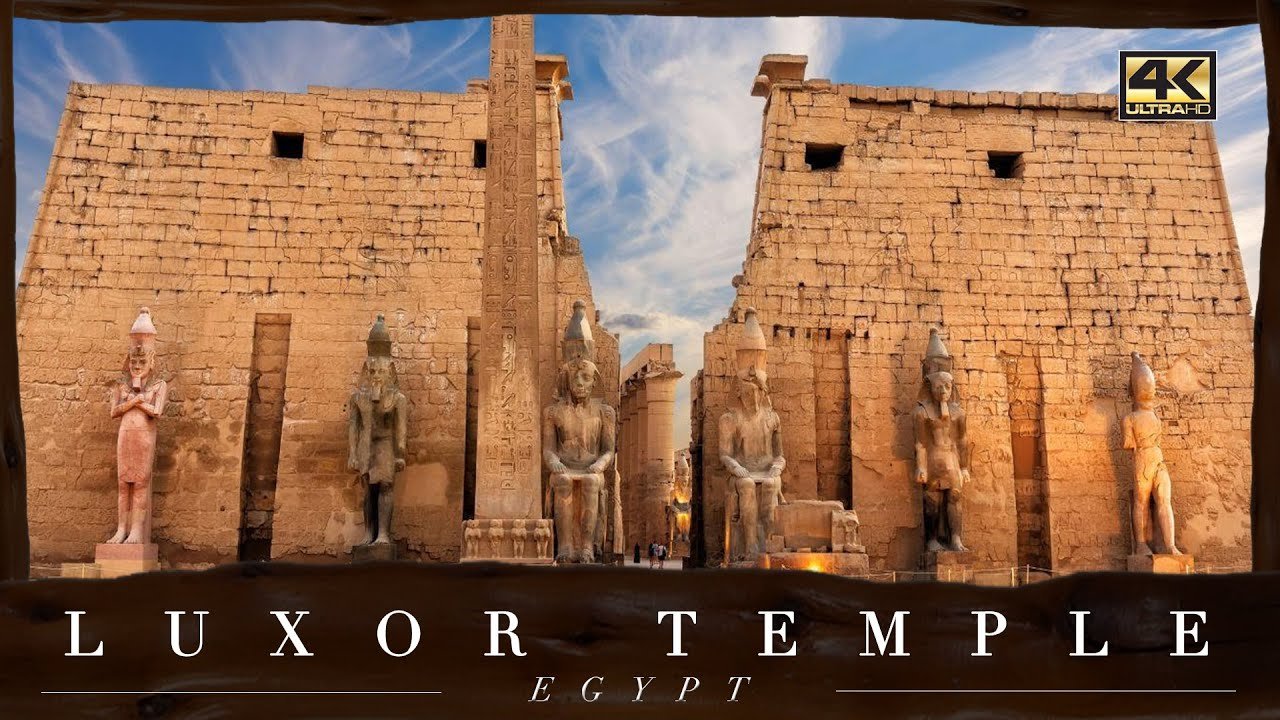Imagine stepping back in time, surrounded by ancient Egyptian architecture and the spiritual essence of the past. Luxor Temple, on the Nile River’s east bank, is a breathtaking monument that draws visitors from everywhere. What secrets does this temple hold, and why is it a marvel of the Pharaonic era? Let’s explore the captivating history and stunning features of this legendary site.
Key Takeaways
- Luxor Temple is one of Egypt’s most well-preserved and significant ancient monuments, dating back to the New Kingdom period (circa 1400 BCE).
- The temple complex is dedicated to the Theban Triad of Amun, Mut, and Khonsu, showcasing the religious beliefs and rituals of ancient Egyptian civilization.
- Luxor Temple features grandiose architecture, including massive columns, imposing statues, and intricately carved hieroglyphic reliefs, exemplifying the architectural prowess of the Pharaohs.
- The temple has been expanded and decorated by various Pharaohs, such as Amenhotep III, Tutankhamun, and Ramses II, reflecting its enduring importance throughout the Pharaonic era.
- Luxor Temple is a UNESCO World Heritage Site, recognized for its outstanding universal value and cultural significance, offering visitors a glimpse into the rich history and legacy of ancient Egypt.
Architectural Marvel of Luxor Temple
Luxor Temple is a true architectural gem, showcasing the grandeur of Pharaonic architecture. The temple’s entrance is marked by a monumental pylon, flanked by towering colossal statues of Ramses II. This creates an imposing and majestic gateway to this ancient wonder. Inside, visitors are greeted by the Colonnade Hall, featuring 14 massive columns adorned with intricate hieroglyphic inscriptions and papyrus-bud capitals.

Monumental Pylons and Towering Columns
The Luxor Temple’s architectural grandeur is further accentuated by its monumental pylons and towering columns. The temple’s massive entrance pylons, constructed by Ramses II, stand as a testament to the power and ambition of the pharaohs. Inside, the Colonnade Hall boasts 14 colossal columns, each over 20 meters tall, creating a breathtaking and awe-inspiring atmosphere.
Intricate Carvings and Hieroglyphics
The walls and columns of the Luxor Temple are adorned with intricate hieroglyphic inscriptions and detailed carvings. These intricate designs depict religious rituals, pharaonic triumphs, and mythological scenes. They offer visitors a unique opportunity to delve into the world of ancient Egyptian beliefs and traditions.
|
Feature |
Details |
|
Construction Period |
Luxor Temple was built around 1400 BCE during the New Kingdom period, with construction and expansion spanning over the 14th and 13th centuries BCE. |
|
Prominent Pharaohs |
The temple was constructed by various pharaohs, including Amenhotep III, Ramses II, Tutankhamun, and Horemheb. |
|
Architectural Highlights |
The temple features a massive pylon built by Ramses II, the Hypostyle Hall, courtyards, and a sanctuary dedicated to the Theban Triad (Amon-Ra, Mut, and Khonsu). |
|
Preservation and Restoration |
Luxor Temple is one of the best-preserved ancient Egyptian temples, with ongoing efforts to preserve and restore its structures and artifacts. |
The Avenue of Sphinxes
Luxor Temple is home to the Avenue of Sphinxes, a 2.7-kilometer-long road. It’s lined with sphinx statues, connecting Luxor Temple to the Karnak Temple Complex. This path was used for ceremonial processions, showing how ancient Egyptians moved their gods’ statues between temples.
The Avenue of Sphinxes had over 600 sphinx statues, as noted in 1809. Though much is buried, nearly a kilometer is visible at Karnak Temple. From 1984 to 2000, 1,057 statues were found, including 807 sphinxes and 250 with ram heads.
|
Statue Type |
Number Uncovered |
|
Sphinx Statues |
807 |
|
Ram Statues |
250 |
|
Total Statues |
1,057 |
The Avenue of Sphinxes restoration took over 70 years. It opened to the public on November 25, 2021. The reopening was celebrated with pharaonic dress, music, lights, dancers, boats, carriages, and golden model boats.
Luxor is a wonder, with the Avenue of Sphinxes showcasing ancient Egypt’s grandeur. Walking this path, visitors are drawn to the statues and the history that still feels alive.
Luxor Temple
The Colonnade Hall and Its Grandeur
The Luxor Temple’s heart is the Colonnade Hall. It was built by Amenhotep III and finished by Tutankhamun and Horemheb. This hall has 14 huge columns with detailed carvings and hieroglyphics.
It’s a place that fills visitors with wonder and awe.
Sanctuary of Amun and Birth Room
Next to the Colonnade Hall is the Sanctuary of Amun. This is where the sacred barque of the god was kept. It shows the temple’s role as a place of worship for the Theban Triad – Amun, Mut, and Khonsu.
The Birth Room is close by. It has reliefs that tell the story of Amenhotep III’s divine birth. This highlights the temple’s royal and ceremonial importance.
“The Colonnade Hall and the Sanctuary of Amun are two of the most impressive and well-preserved features of the Luxor Temple, providing a glimpse into the grandeur and religious significance of this ancient site.”
The Luxor Temple is a window into ancient Egypt’s architecture and history. Visitors can see these amazing spaces. They can learn about the temple’s role in the lives of pharaohs and Theban people.
Night-Time Illuminations at Luxor Temple
Luxor Temple, one of Egypt’s most iconic sites, shines in a new light after sunset. The night-time illuminations turn the ancient architecture into a stunning sight. It creates a magical atmosphere for all who visit.
As dusk falls, the temple’s massive pylons, columns, and carvings come alive with light. The lighting highlights the temple’s grandeur, casting a spellbinding glow over the site.
Visitors can also enjoy Luxor’s lively nightlife along the Luxor Corniche. It offers a peaceful and magical setting. Felucca rides on the Nile give a special view of the lit landmarks. The Luxor Night Market is full of interesting goods, from clothes and jewelry to local souvenirs.
Exploring Luxor Temple at night is an experience you won’t forget. It’s a chance to see ancient architecture and enjoy the city’s lively nightlife. A visit to Luxor Temple under the stars is unforgettable.
Location and Accessibility
Luxor Temple is right in the middle of Luxor City. It’s easy to get to for anyone visiting. You can walk or take a taxi to get there. It’s close to the Karnak Temple Complex and the Luxor Museum.
Situated in the Heart of Luxor City
The Luxor Temple is in the city center. This makes it simple to add to your travel plans. You can walk, take a taxi, or join a tour to see it.
Being near the Karnak Temple Complex and Luxor Museum is a big plus. It lets visitors dive deep into ancient Egypt’s culture and buildings. Seeing these places together helps you understand and love the area’s history and traditions more.
Opening Hours and Ticketing
Luxor Temple in Egypt is open every day from 6 AM to 10 PM. This lets visitors see its beauty whenever they want. Tickets cost 160 Egyptian pounds (about £7/$8) for adults at the entrance.
Students get a discount, paying only 20 Egyptian pounds with a student card. This makes it easier for them to explore.
Guided tours are available for 100 to 150 Egyptian pounds. You can also get a photography permit for 20 Egyptian pounds. This lets you take amazing photos of the temple’s sights and details.
The best time to visit is early morning or late evening. These times are less busy, offering a calm atmosphere. Luxor Temple is a must-see for its stunning architecture and history.
|
Opening Hours |
Ticket Prices |
Discounts |
|
Daily: 6 AM to 10 PM |
General Admission: 160 Egyptian pounds (around £7/$8) |
Students: 20 Egyptian pounds |
|
Guided Tour: 100-150 Egyptian pounds |
Groups: Discounted rates available |
|
|
Photography Permit: 20 Egyptian pounds |
Guided Tours with Egypt Cruise Planners
For the best experience at Luxor Temple, book a guided tour with Egypt Cruise Planners. Our guides share fascinating stories and details. They offer tours in many languages, making sure you have a great time.
Enriching Experiences with Expert Guides
Egypt Cruise Planners has a team of Egyptologists and local experts. They love sharing their knowledge of Luxor Temple. You’ll learn about the temple’s history, architecture, and religious importance.
Our tours are customized to fit your interests. Whether you want to know about history, architecture, or rituals, we’ve got you covered. Our guides make the temple’s history come alive.
Book your guided tour with Egypt Cruise Planners today. Explore Luxor Temple’s wonders with our expert guides. Discover its architectural and religious significance.

Religious Significance of Luxor Temple
The Temple of Luxor was a key place for ancient Egyptian worship. It was dedicated to the Theban Triad – Amun, Mut, and Khonsu. Built around 1300 BC, it’s older than ancient Greece’s Golden Age.
The temple was mainly for Amun, the king of gods. It was vital for rituals that made pharaohs’ rule legit. The Opet Festival, lasting from 11 to 27 days, was a time of spiritual renewal.
The temple also honored Mut and Khonsu, Amun’s wife and son. Together, they were the Theban Triad, central to Egyptian beliefs. The temple’s carvings show the Theban Triad’s journey during the Opet Festival.
Luxor Temple’s legacy shows its deep religious significance to ancient Egyptians. Its ongoing importance and restoration efforts will keep it a wonder for future visitors.
Historical Events and Ceremonies
Luxor Temple is a stunning ancient Egyptian wonder. It has seen many important events and ceremonies over the years. The famous Opet Festival was a key event, lasting weeks with grand processions and rituals.
The temple was also the setting for royal ceremonies, like the coronation of pharaohs. These ceremonies were to show the ruler’s divine right to the throne. Luxor Temple played a big role in ancient Egypt’s politics and religion.
- Luxor Temple was built around 1400 BCE during the reign of Amenhotep III.
- The temple changed during Pharaoh Akhenaten’s time to honor the sun god, Aten.
- The Opet Festival featured the gods Amun, Mut, and Khonsu in boat-like shrines. They were carried from Karnak in a grand procession.
- The path to Luxor Temple for the festival was lined with sphinxes. It attracted many, including priests, soldiers, and musicians.
These events and ceremonies made Luxor Temple a sacred and powerful place in ancient times. They show its deep connection to Ancient Egyptian history.
Rediscovery and Restoration Efforts
Luxor Temple, a stunning ancient Egyptian site, was hidden for centuries. It was rediscovered in recent times. Excavation started in the 19th century, revealing its stunning structures and artifacts.
Since then, Luxor Temple has seen major restoration and conservation work. This work aims to keep its ancient beauty and history alive for future generations.
Preserving the Legacy for Future Generations
The restoration of the Luxor Temple is a continuous effort. Experts use advanced methods to protect its delicate artifacts and structures. This allows visitors to see ancient Egypt’s grandeur up close.
They can admire the detailed carvings and hieroglyphics on the temple’s walls. The Egyptology community has worked tirelessly to restore this landmark. They ensure its rich legacy is shared with future generations.
|
Statistic |
Value |
|
Height of Colossi of Memnon statues |
70 feet |
|
Duration of pharaonic history in Luxor |
Over 1,000 years |
|
Significant temples in Luxor |
Karnak Temple and Luxor Temple |
|
Peak of Egyptian cultural and artistic achievements |
New Kingdom (ca. 1550–1070 B.C.) |
|
Pharaoh who ascended the throne at age nine |
Tutankhamun |
|
Pharaoh known for extensive building campaign in Thebes |
Amenhotep III |
The rediscovery and excavation of Luxor Temple have been key moments in Egyptology. They have shed light on ancient Egyptian civilization’s grandeur and complexity. Thanks to researchers and experts, the temple’s restoration and preservation continue.
This ensures Luxor Temple remains a symbol of the Nile Valley’s rich cultural heritage.
Practical Tips for Visiting Luxor Temple
Visiting Luxor Temple in Egypt is a must for anyone in the area. Here are some tips to make your visit great:
Hire a Knowledgeable Guide
A knowledgeable guide can make your Luxor Temple visit better. They know a lot about the temple’s history and culture. You’ll leave with a deeper understanding of this ancient place.
Wear Comfortable Attire
The temple has uneven paths, so wear comfy shoes. Also, bring a hat, sunscreen, and water. This is important during the hot summer.
Accessible Location
Luxor Temple is in the heart of Luxor city. It’s easy to get there by taxi or walking from most hotels. This makes it easy to fit into your Luxor trip.
Guided Tours and Transportation
Many tours include Luxor Temple. They often include transportation and visits to other sites. These tours are a convenient way to see the temple and learn about it.
Packing Tips
- Comfortable walking shoes
- Hat or sun hat
- Sunscreen
- Water and snacks
- Camera (with extra batteries)
- Small backpack or day bag
With these tips, you’ll have a great time at Luxor Temple. It’s one of Egypt’s most famous and well-kept ancient sites.
Conclusion
The Luxor Temple is a symbol of ancient Egypt’s greatness. Its stunning architecture and detailed reliefs are a must-see for history buffs. The temple’s design shows the pharaohs’ achievements in religion, politics, and art.
Visiting Luxor Temple is an experience you won’t forget. It’s even more magical at night when it’s lit up. Being a UNESCO World Heritage site, it’s a treasure that needs to be saved for future generations.
Exploring Luxor Temple takes you back in time. It’s a place where history, culture, and wonder meet. Whether you love history or just appreciate great architecture, Luxor Temple will amaze you and deepen your respect for ancient Egypt.
Read other related articles:
- Top Ancient Egyptian Temples You Must Visit
- Is Nile Cruise Worth It? Ultimate Travel Guide
- Types of Nile Cruises: Which is Best for Your Trip

